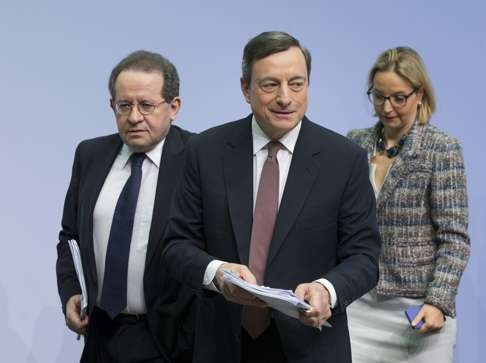
New | Fed’s Yellen mulls way forward as European Central Bank opts to stay put to see if stimulus works
Betting is on an eventual rate rise by Fed; question is how to head off rally in US dollar if rates gain
Mario Draghi has opened a door. Janet Yellen has to decide whether she wants to walk through.
The European Central Bank president signalled last week that policy on his side of the Atlantic is going on hold as officials wait to see how their stimulus measures play out. That pause may hand the US Federal Reserve chair an opportunity to raise interest rates in coming months, by reducing the risk of a sharp rally in the dollar if the policies of the two central banks conspicuously diverged.
“The reality for the ECB is the euro zone isn’t in nearly as bad a shape as Draghi would like to make out -- it pushes the currency and gives the Fed far more room to move,” said Rob Carnell, chief international economist at ING Bank NV in London. “Sometime in the third quarter sounds like a reasonable bet for me but I wouldn’t rule out the second quarter.”
Investors see zero probability the Federal Open Market Committee will hike at its April 26-27 meeting and only about 20 per cent chance of a move at its gathering in June, eight days before Britain holds a referendum on whether to remain in the European Union.

A vote by UK citizens to depart could trigger financial-market turmoil and is a source of uncertainty that may give the Fed pause. The likelihood of a move in July is 33 per cent, according to prices in federal funds futures contracts.
US policy makers expect to raise rates twice this year, according to projections they updated in March. A gradual recovery in the euro area that supports an appreciation in the single currency will strengthen their case, though the US economy still faces obstacles.
At the start of the year, the dollar reached the highest level since 2002 in trade-weighted terms, but has eased back from that peak and the US currency has also lost ground against the euro. A stronger dollar has been a factor in holding down too-low inflation through cheaper import prices as well as denting growth by hurting exports.
Stefan Schneider, international economist at Deutsche Bank AG in Frankfurt, said the ECB’s shift into holding mode makes it easier for the US central bank to tighten monetary policy, though he doesn’t see the move coming soon.
“The Fed has a bit more leeway because the dollar strength cited by Yellen as an argument for caution has ebbed recently,” he said. “But the economy doesn’t currently give the Fed any reason to rush.”

US growth appears to have slowed in the first quarter, with some economists cutting their tracking estimates to near zero, following a 1.4 per cent gain in the final three months of last year. It may take time to resolve whether this means the economy is suffering a temporary soft patch, as it did this time last year, or has stalled the recovery.
Inflation is still too low, held down by lower energy prices and a stronger dollar, and has been below the Fed’s preferred gauge of price pressures since 2012. Wages are also subdued, suggesting there’s still slack in the labour market, despite a 5 per cent unemployment rate in March that Fed officials say is near their estimates for full employment.
On the other hand, some risks that were prominent in the policy debate earlier this year have faded. Financial conditions have eased and China’s economic outlook appears to have stabilised, with the International Monetary Fund predicting that the world’s second-largest economy will slow less than previously anticipated. A gauge of inflation expectations in the bond market rose to the highest level in nine months on Monday after a three-week run of gains in oil.
Investors still only see a 63 per cent chance the Fed will have raised rates once by December, though Eric Rosengren, president of the Boston Fed and one of the central bank’s most dovish officials, has warned that this view was too pessimistic. Economists surveyed by Bloomberg in early April predicted the next rate increase will come in June, followed by another one in December.
Yellen herself said March 29 that “caution is especially warranted.”
For Thomas Costerg, a senior US economist at Standard Chartered Bank in New York, that means the Fed won’t raise rates this month and will refrain from sending a clear signal about June.
“Still, the Fed is unlikely to encourage markets to discount further Fed rate hikes -- expectations are already very low,” he said. “At the margin, a hawkish surprise seems more likely than a dovish one.”

